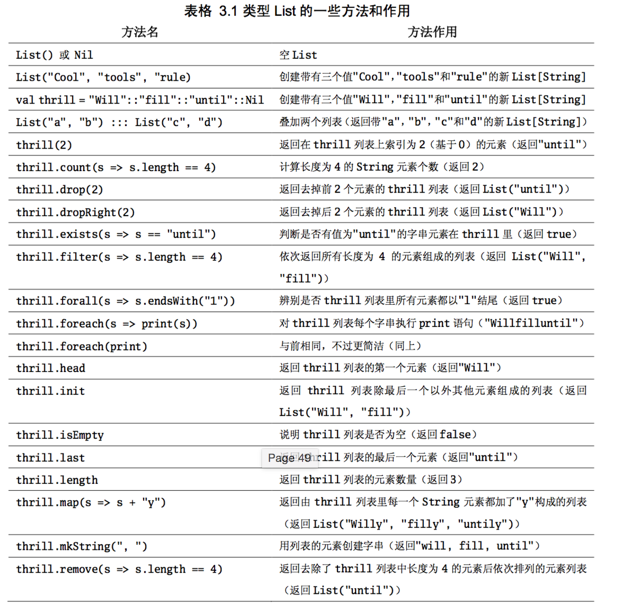1 介绍
Scala中列表List类似于数组,List所有元素都具有相同的类型,但有两个重要的区别。
- 首先,列表是不可变的,这意味着一个列表的元素可以不被分配来改变。
- 第二,列表表示一个链表,而数组平坦的。
具有T类型的元素的列表的类型被写为List[T]。例如,这里有各种数据类型定义的一些列表:
// List of Strings
val fruit: List[String] = List("apples", "oranges", "pears")
// List of Integers
val nums: List[Int] = List(1, 2, 3, 4)
// Empty List.
val empty: List[Nothing] = List()
// Two dimensional list
val dim: List[List[Int]] =
List(
List(1, 0, 0),
List(0, 1, 0),
List(0, 0, 1)
)
List是不可变的,操作List返回的是新的List对象.
val l = List(1,2,3,4,5)
List中元素类型是一致,上面的l类型就是List[Int]

2 创建List
(1) Lisp-style and Java-style
scala> val list = 1 :: 2 :: 3 :: Nil list: List[Int] = List(1, 2, 3) scala> val list = List(1,2,3) x: List[Int] = List(1, 2, 3)
(2) range函数。
scala> val x = List.range(1,10) x: List[Int] = List(1, 2, 3, 4, 5, 6, 7, 8, 9) scala> val x = List.range(0,10,2) x: List[Int] = List(0, 2, 4, 6, 8) //或者直接使用 toList val list3 = 10 to 20 toList list3: List[Int] = List(10, 11, 12, 13, 14, 15, 16, 17, 18, 19, 20)
(3) fill函数
scala> val x = List.fill(3)("foo")
x: List[java.lang.String] = List(foo, foo, foo)
(4) tabulate
List.tabulate() 方法是通过给定的函数来创建列表。
方法的第一个参数为元素的数量,可以是二维的,第二个参数为指定的函数,我们通过指定的函数计算结果并返回值插入到列表中,起始值为 0,实例如下:
object Test {
def main(args: Array[String]) {
// Creates 5 elements using the given function.
val squares = List.tabulate(6)(n => n * n)
println( "squares : " + squares )
//
val mul = List.tabulate( 4,5 )( _ * _ )
println( "mul : " + mul )
}
}
输出结果
C:/>scalac Test.scala
C:/>scala Test
squares : List(0, 1, 4, 9, 16, 25)
mul : List(List(0, 0, 0, 0, 0), List(0, 1, 2, 3, 4),
List(0, 2, 4, 6, 8), List(0, 3, 6, 9, 12))
3 增加元素
val left = List(1,2,3) val right = List(4,5,6) //合并两个List left ++ right // List(1,2,3,4,5,6) left:::right // List(1,2,3,4,5,6) right:::left // List(4,5,6,1,2,3) right.:::(left) // List(1,2,3,4,5,6) left.:::(right) // List(4,5,6,1,2,3) //在List头部添加元素 0::left //List(0,1,2,3) left.::(0) //List(0,1,2,3) 0+:left //List(0,1,2,3) //在List尾部添加元素 left :+ 4 //List(1,2,3,4)
任何以冒号结果的操作符,都是右绑定的,即 0 :: List(1,2,3) = List(1,2,3).::(0) = List(0,1,2,3) 从这里可以看出操作::其实是右边List的操作符,而非左边Int类型的操作符
4 迭代List
scala> val x = List(1,2,3)
x: List[Int] = List(1, 2, 3)
scala> x.foreach { println }
1
2
3
scala> var sum = 0
sum: Int = 0
scala> val x = List(1,2,3)
x: List[Int] = List(1, 2, 3)
scala> x.foreach(sum += _)
scala> println(sum)
6
scala> val names = List("Bob", "Fred", "Joe", "Julia", "Kim")
names: List[java.lang.String] = List(Bob, Fred, Joe, Julia, Kim)
scala> for (name <- names if name.startsWith("J"))
| println(name)
Joe
Julia
scala> val x = List(1,2,3,4,5,6,7,8,9,10)
x: List[Int] = List(1, 2, 3, 4, 5, 6, 7, 8, 9, 10)
// create a list of all the even numbers in the list
scala> val evens = x.filter(a => a % 2 == 0)
evens: List[Int] = List(2, 4, 6, 8, 10)
5 map函数
The Scala List map function "transforms each element of a collection based on a function."
scala> val x = List(1,2,3) x: List[Int] = List(1, 2, 3) scala> val y = x.map(a => a * 2) y: List[Int] = List(2, 4, 6)
scala> val y = x.map(_ * 2) y: List[Int] = List(2, 4, 6)
更具体的map、flattenMap等见http://www.cnblogs.com/yxzfscg/p/4997182.html
http://my.oschina.net/brucegao/blog/372362
http://www.yiibai.com/scala/scala_lists.html
http://www.scala-lang.org/api/current/index.html#scala.collection.immutable.List
http://alvinalexander.com/scala/scala-list-class-examples
http://www.oschina.net/code/snippet_226405_19569